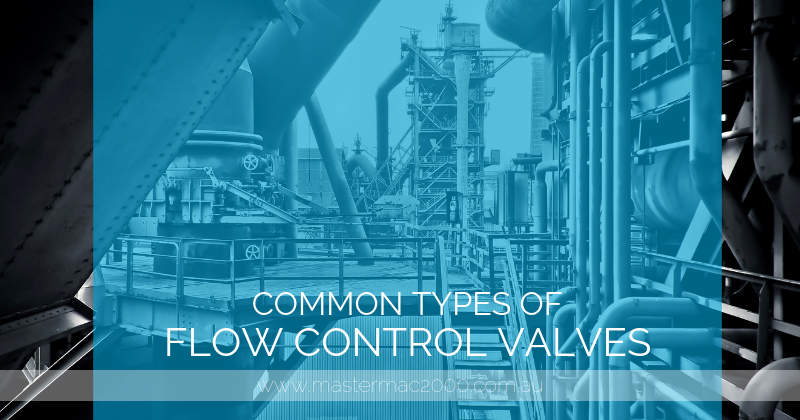Common Types of Flow Control Valves

Numerous types of flow control valves are used in different applications and industries. They vary from being simple to sophisticated, and some are complicated enough to adjust temperature and pressure variations automatically.
Check out the most common flow control valves:
Globe valves. This type of valve consists of a stationary ring and movable disk-type element seat in a spherical body. This is different from ball valves as it is used to start, stop, and regulate flow in a pipeline. Globe valves operate in a linear motion and close via a flat plug or convex bottom that is lowered onto a horizontal seat. Also, the plug raises when a user opens the valve to allow fluid to flow.
Gate valves. Generally, these valves are primarily used for non-throttling service and applications that require a straight line flow of liquid with less restriction. When operating gate valves, you’ll have to rotate the stem in a counter-clockwise motion to open it and a clockwise motion to close the valve. And when an operator moves the stem, the gate moves up and down on the threaded step.
Diaphragm Valves. These valves are consist of a flexible disk that contacts with a seat at the top of a valve body and creates a seal. The diaphragm valves are pressure responsive and flexible which are used to control, open, or close a valve. They use an elastomeric diaphragm rather than elastomeric liner in the body of the valve. The elastomeric diaphragm is attached to a compressor, which separates the flow stream.
Pinch valves. These are ideal for applications of liquids or slurries containing large amounts of suspended solids. These type of valves seal one or more flexible materials such as rubber tubes that pinch to turn off the flow of liquids. The only wetted part of the valve is the rubber sleeves. Their flexibility allows these valves to close tightly entrapping solids.
Needle valves. These are volume control valves that create a restriction flow in small lines. Fluids that go through these valves turn 90 degrees and flow through an orifice that serves as the seat for a cone-shape-tipped rod. When the user operates the cone on the seat, the orifice changes in size. Needle valves are similar to globe valves as they share a few features and benefits.
No matter the type of flow control valves, they are all designed to regulate the pressure or flow of fluids and they react to signals created by temperature gauges or flow meters. It is essential to use these valves to their specific functions to avoid any problems.

About MasterMac2000: Your Trusted Pneumatic & Process Automation Partner.
LEADING THE INDUSTRY: Established in 1989, MasterMac2000 has grown to become one of Australia's largest privately owned pneumatic and process automation companies. We stock top-quality brands like Univer, Mack, Tolomatic, Mac, Piab, American, and Rotoflux in Brisbane.
SERVING QLD & NORTHERN NSW: We proudly service Queensland and Northern New South Wales for all your pneumatic and process equipment needs. Our mission is to provide the best pre and post-sales support while actively expanding our client base.
SOURCING HARD-TO-FIND PARTS: Not only do we stock quality components, but we also excel at sourcing those elusive, hard-to-find parts. With our extensive database and global network of contacts, getting the parts you require is as easy as a call to our highly skilled, professional sales team.
DEDICATED TO YOUR SUCCESS:
- Decades of expertise in pneumatics & process automation
- Carefully curated selection of world-class brands
- Exceptional sourcing capabilities for speciality parts
- Knowledgeable sales staff dedicated to finding solutions
- Unwavering commitment to customer service excellence
About The Author
Stuart Havill
Stuart Havill is the owner and manager of MasterMac2000, Queensland's largest privately owned pneumatic and process valve company.
With his early working career as a maintenance fitter for Boral in 1992, Stuart has spent his life in the field of pneumatics and process equipment. He gained extensive experience in plant design, maintenance, repairs, fabrication, and site management.
In 1996, he transitioned to a pneumatic sales technician role at MasterMac2000, where he excelled in key account management, providing cost-effective solutions, and managing a sales team of 9 employees.
Since 2002, Stuart has been the manager at MasterMac2000, overseeing the company's growth and establishing it as a leader in pneumatic automation and process valve engineering. His expertise spans customer training, CRM setup, industrial compressor sizing and installation, and turn-key project management.
Under Stuart's leadership, MasterMac2000 has been servicing the industry since 1988, with 5 full-time sales representatives covering northern rivers NSW, Queensland, Northern Territory, and PNG. The company prides itself on providing the best-priced solutions to all customers in the marketplace.
View Stuart’s LinkedIn profile to learn more about his expertise in pneumatics and process equipment.